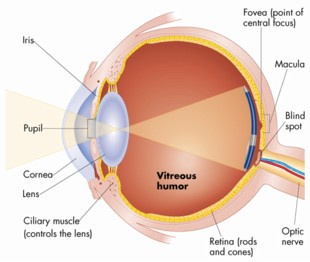ASTR 1230 (O'Connell) Lecture Notes
THE HUMAN EYE AS A DETECTOR

Structure and Function of the Eye
With or without optical aid, the only light detector most of you will use in this course is the human eye. Although we take its operation for granted, the eye is, in fact, a remarkably capable optical instrument (an auto-focus, auto-exposure, electrical camera), and it is important to understand some aspects of its behavior.- The eye operates like a camera, with a lens, an iris, and a retina.
- The refractive lens is filled with fluid, and its shape can be adjusted by the surrounding muscles so that a sharp ("in focus") image is produced on the retina over a range of distances to objects being viewed. Limitations in the ability to adjust the lens produce the phenomena of "near-sightedness" and "far-sightedness." The angular resolution of the lens-plus-detector system of the eye is typically 1-2 minutes of arc.
- The iris automatically adjusts the eye's input aperture ("pupil") diameter according to the prevailing light level. This provides a focal-ratio for the eye in the range f/3 to f/8 (approximately). The largest aperture size, under very dark conditions, is about 5-7mm.
- The retina is a complex photo-detection system. Light falling
on retinal cells triggers chemical changes that produce an electrical
signal which is sent down the optic nerve to the brain.
- There are two kinds
of photo-receptor cells in
the retina: rods and
cones. The cones are less numerous and operate only at
high light levels, where they provide information on color
as well as the brightness of scenes. The rods are more sensitive,
so they operate best at low light levels; but they produce only a
"grey-scale" image without elements of color.
- Dynamic range: in a given scene, the eye can distinguish levels of illumination that have a brightness range of about 100:1, so it is said to have a dynamic range of 100. The maximum range of brightnesses detectable by the eye, after adjustments such as dark adaptation, is a remarkable 1,000,000:1.
- Integration time: the eye automatically adjusts the time interval during which it accumulates light energy before sending an image to the brain. This interval is called the "integration time" and is typically 0.1 sec; it increases to perhaps 0.2 sec for low-light levels. The reason that astronomical images show so much more detail than you can see with your eye is mainly due to the fact that cameras can have very long integration times, up to hours if necessary.
Dark Adaptation
Under the very low light conditions you will typically encounter when observing faint sources through a telescope, the rods slowly become more sensitive. It takes over 20 minutes to achieve highest sensitivity, or "full dark adaptation," but reasonable sensitivity is present in about 5 minutes. You must avoid looking at bright lights to become and stay dark-adapted. Because the rods are less sensitive to red light, using a red flashlight helps to preserve night vision.Averted Vision
The rods are preferentially distributed toward the edge of the retina, which is therefore more sensitive to faint sources. This is the basis for the "averted vision" observing technique: stare at a point about 20 degrees away from the object of interest but focus your attention on the target.Web Links:
-
Slovak
translation of this page
WEBVISION (technical
description of retina/visual system)
Visual
Observing Techniques (Dan Elton)
Astronomical
Imaging (O'Connell, Lecture 7)
 Back to Lecture 1
Back to Lecture 1
|
 Lecture Index
Lecture Index
|
Last modified December 2020 by rwo
Copyright © 2008-2020 Robert W. O'Connell. All rights reserved. These notes are intended for the private, noncommercial use of students enrolled in Astronomy 1230 at the University of Virginia.